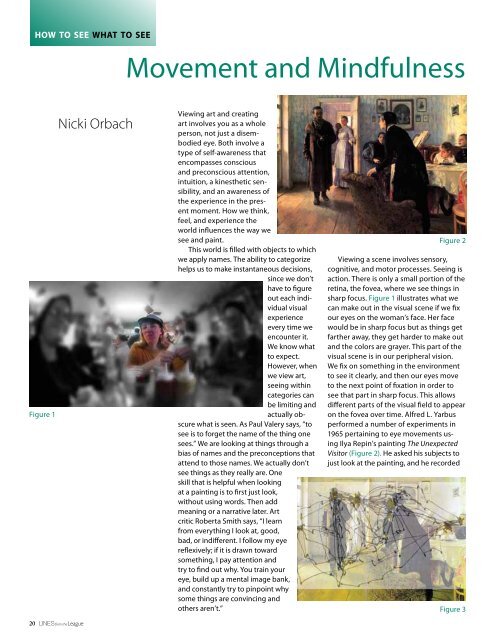League
LinkClick
LinkClick
Create successful ePaper yourself
Turn your PDF publications into a flip-book with our unique Google optimized e-Paper software.
how to see<br />
what to see<br />
Movement and Mindfulness<br />
Figure 1<br />
20 LINES from the <strong>League</strong><br />
Nicki Orbach<br />
Viewing art and creating<br />
art involves you as a whole<br />
person, not just a disembodied<br />
eye. Both involve a<br />
type of self-awareness that<br />
encompasses conscious<br />
and preconscious attention,<br />
intuition, a kinesthetic sensibility,<br />
and an awareness of<br />
the experience in the present<br />
moment. How we think,<br />
feel, and experience the<br />
world influences the way we<br />
see and paint.<br />
This world is filled with objects to which<br />
we apply names. The ability to categorize<br />
helps us to make instantaneous decisions,<br />
since we don’t<br />
have to figure<br />
out each individual<br />
visual<br />
experience<br />
every time we<br />
encounter it.<br />
We know what<br />
to expect.<br />
However, when<br />
we view art,<br />
seeing within<br />
categories can<br />
be limiting and<br />
actually obscure<br />
what is seen. As Paul Valery says, “to<br />
see is to forget the name of the thing one<br />
sees.” We are looking at things through a<br />
bias of names and the preconceptions that<br />
attend to those names. We actually don’t<br />
see things as they really are. One<br />
skill that is helpful when looking<br />
at a painting is to first just look,<br />
without using words. Then add<br />
meaning or a narrative later. Art<br />
critic Roberta Smith says, “I learn<br />
from everything I look at, good,<br />
bad, or indifferent. I follow my eye<br />
reflexively; if it is drawn toward<br />
something, I pay attention and<br />
try to find out why. You train your<br />
eye, build up a mental image bank,<br />
and constantly try to pinpoint why<br />
some things are convincing and<br />
others aren’t.”<br />
Figure 2<br />
Viewing a scene involves sensory,<br />
cognitive, and motor processes. Seeing is<br />
action. There is only a small portion of the<br />
retina, the fovea, where we see things in<br />
sharp focus. Figure 1 illustrates what we<br />
can make out in the visual scene if we fix<br />
our eyes on the woman’s face. Her face<br />
would be in sharp focus but as things get<br />
farther away, they get harder to make out<br />
and the colors are grayer. This part of the<br />
visual scene is in our peripheral vision.<br />
We fix on something in the environment<br />
to see it clearly, and then our eyes move<br />
to the next point of fixation in order to<br />
see that part in sharp focus. This allows<br />
different parts of the visual field to appear<br />
on the fovea over time. Alfred L. Yarbus<br />
performed a number of experiments in<br />
1965 pertaining to eye movements using<br />
Ilya Repin’s painting The Unexpected<br />
Visitor (Figure 2). He asked his subjects to<br />
just look at the painting, and he recorded<br />
Figure 3


